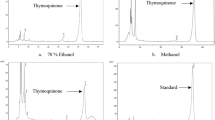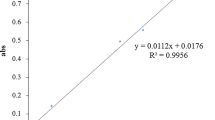Abstract
There is a great interest in the nutritional value of vegetables and fruits and how the habitat affects nutritive and biological properties. In vitro studies here reported were performed to evaluate the inhibitory activity of formulations from edible plant on pancreatic lipase. The aim of this study was also to evaluate the biovariability of L. comosa (L.) Parl. bulbs from Italy. The wild bulbs were compared with the same cultivated species that are commonly commercialized to identify samples with the best quality for a potential therapeutic application. Hydroalcoholic extract and polar fraction of wild bulbs showed a very important pancreatic lipase inhibitory activity, with IC50 values of 0.166 ± 0.005 and 0.153 ± 0.005 mg/mL, respectively. In order to characterize the extracts, gas chromatography associated with mass spectrometry (GC/MS) analysis was performed, revealing the predominance of palmitic acid. Phenolic and flavonoid composition was also evaluated. L. comosa extract obtained from wild bulbs demonstrated both antioxidant and anti-obesity activities that might be attributed to a wide range of present phenolic compounds.

Similar content being viewed by others
References
Pignatti S (1982) Flora d'Italia. Edagricole, Bologna
Conti F, Abbate G, Alessandrini A, Blasi G (2005) An annotated checklist of the Italian vascular Flora. Palombi editori, Roma
Guarrera PM, Salerno G, Caneva G (2005) Folk phytotherapeutical plants from Maratea area (Basilicata, Italy). J Ethnopharmacol 99:367–378
Guarrera PM (2000) I Sapori del quotidiano. In: Museo Nazionale delle Arti e Tradizioni Popolari, Guida, by Massari S. Marsilio ed, Venezia, pp 139–146
Adinolfi M, Barone G, Corsaro MM, Lanzetta R, Mangoni L, Parrilli M (1987) Glycosides from Muscari comosum, 7. Structure of three novel muscarosides. Can J Chem 65:2317–2326
Marrelli M, Conforti F, Araniti F, Statti GA (2016) Effects of saponins on lipid metabolism: a review of potential health benefits in the treatment of obesity. Molecules 21:1404
Kaur J (2014) A comprehensive review on metabolic syndrome. Cardiol Res Pract 2014
Marrelli M, Loizzo MR, Nicoletti M, Menichini F, Conforti F (2014) In vitro investigation of the potential health benefits of wild Mediterranean dietary plants as anti-obesity with α-amylase and pancreatic lipase inhibitory activities. J Sci Food Agric 94:2217–2224
Conforti F, Perri V, Menichini F, Marrelli M, Uzunov D, Statti GA, Menichini F (2012) Wild Mediterranean dietary plants as inhibitors of pancreatic lipase. Phytother Res 26:600–604
Marrelli M, Loizzo MR, Nicoletti M, Menichini F, Conforti F (2013) Inhibition of key enzymes linked to obesity by preparations from Mediterranean dietary plants: effects on α-amylase and pancreatic lipase activities. Plant Foods Hum Nutr 68:340–346
Savini I, Catani MV, Evangelista D, Gasperi V, Avigliano L (2013) Obesity-associated oxidative stress: strategies finalized to improve redox state. Int J Mol Sci 14:10497–10538
Birari Bhutani KK (2007) Pancreatic lipase inhibitors from natural sources: unexplored potential. Drug Discov Today 12:879–889
Loizzo MR, Tundis R, Menichini F, Frega G (2011) Radical scavenging activity and cholinesterase inhibitory activity of Leopoldia comosa (L.) bulbs. Prog Nutr 13:300–303 http://mattioli1885journals.com/index.php/progressinnutrition/article/view/1505
Author information
Authors and Affiliations
Corresponding author
Ethics declarations
Conflict of interest
None.
Electronic supplementary material
Online Resource 1
Materials and Methods (PDF 113 kb)
Online Resource 2
Yield% of extractions of Leopoldia comosa (L.) Parl. hydroalcoholic extracts and fraction. (PDF 52 kb)
Online Resource 3
Total phenolic (TP) and flavonoid (TF) content of Leopoldia comosa (L.) Parl. hydroalcoholic extracts. Total phenolics (TP) were expressed as chlorogenic acid equivalents in mg per g of crude extract. Total flavonoids (TF) were expressed as quercetin equivalents in mg per g of raw extract. Results are expressed as mean ± SD (n = 3). (PDF 276 kb)
Online Resource 4
Statistically significant features identified through t-test. (PDF 49 kb)
Rights and permissions
About this article
Cite this article
Marrelli, M., La Grotteria, S., Araniti, F. et al. Investigation of the Potential Health Benefits as Lipase Inhibitor and Antioxidant of Leopoldia comosa (L.) Parl.: Variability of Chemical Composition of Wild and Cultivated Bulbs. Plant Foods Hum Nutr 72, 274–279 (2017). https://doi.org/10.1007/s11130-017-0618-1
Published:
Issue Date:
DOI: https://doi.org/10.1007/s11130-017-0618-1




